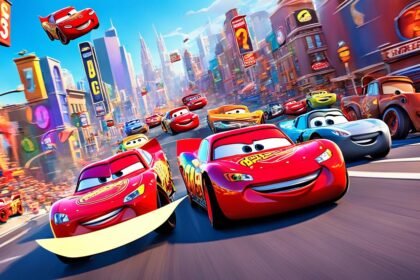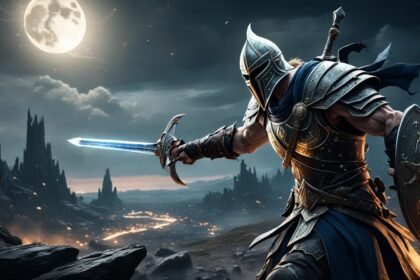The story of Cinderella is known and loved worldwide. It began as an old folktale. Now, it’s known everywhere as a story of resilience and dreaming big.
Disney’s movie, released in 1950, had a big impact. It showed things like the glass slipper, the Fairy Godmother, and the importance of true love. These ideas are still found in many versions today.
Recently, there are new takes on Cinderella. Films like “Ever After” and “Cinderella” give the story a fresh feel. They push against old ideas on gender and focus on making your own path.
Writers are also changing Cinderella to fit different cultures. For example, Marissa Meyer made Cinderella part of a sci-fi series. And Malinda Lo wrote a version with a queer theme. These stories show Cinderella can be for everyone, no matter their background.
Key Takeaways:
- Cinderella’s story shows the power of not giving up and of chasing your dreams.
- The 1950 Disney movie influenced how people see Cinderella’s story today.
- “Ever After” and “Cinderella” tell the story in new and exciting ways.
- Writers are making Cinderella fit today’s more diverse world.
- Cinderella is still popular because its message is timeless, touching all who seek hope and strength.
Historical Origins: Tracing the Cinderella Story across Cultures
The Cinderella story has its roots in diverse cultures and time periods. We often associate it with Disney’s movie and the glass slipper. But, its origins trace back far beyond these, showing its rich history.
In ancient China, a ninth-century story called “Yeh-Shen” shared the essence of Cinderella. It tells of a girl named Yeh-Shen who overcame struggles to find happiness.
Yet, the tale we know today was shaped by Charles Perrault, a French author in the 17th century. He added key features like the Fairy Godmother and the famous glass slipper. These elements truly captured the hearts and imaginations of many.
After Perrault, many creatives have molded the Cinderella story to fit their style. From Marcia Brown’s celebrated book to various other versions worldwide, Cinderella has seen many forms.
The Cinderella story is not limited to Europe or the West. It has reached across the globe, including Africa with stories like “Mufaro’s Beautiful Daughters.” Each version adds its own cultural flair, keeping the story vibrant and relevant.
Even within the U.S., we find unique Cinderella adaptations from different cultures. Native Americans tell “The Rough-Face Girl,” focusing on the beauty within. Mexicans have “Domitila,” weaving in their rich heritage.
Many cultures have embraced the Cinderella tale, making it truly universal. It reminds us all that with perseverance and belief, anyone can achieve their dreams, leading to a happy ending.
Archetypal Characters: Analyzing the Role of Cinderella, the Fairy Godmother, and the Wicked Stepmother
The story of Cinderella is full of archetypal characters with symbolic meanings. Each one brings something unique. They make the story more impactful and relatable.
Cinderella: Resilience and Self-Actualization
Cinderella shows incredible resilience and the power to realize her true self. She faces tough times but stays strong. Her journey to becoming a princess shows the importance of never giving up on dreams.
She is a beacon of hope for people going through hard times. Her story teaches us to keep dreaming and find strength within ourselves.
The Fairy Godmother: Hope and Guidance
The Fairy Godmother is the essential figure of hope and guidance in Cinderella’s life. She uses magic to turn Cinderella’s life around. This shows us that help can come from unexpected places. She brings magic and wonder to the story.
The Wicked Stepmother: Obstacles and Injustice
The Wicked Stepmother is the source of many troubles for Cinderella. She symbolizes the unfair obstacles in life. The Wicked Stepmother’s cruelty highlights the story’s themes of overcoming adversity and standing strong.
Archetypal Characters in Cinderella
| Archetypal Character | Symbolic Significance |
|---|---|
| Cinderella | Resilience and self-actualization |
| Fairy Godmother | Hope and guidance |
| Wicked Stepmother | Obstacles and injustice |
Understanding the archetypal characters deepens our connection to Cinderella’s tale. They show us powerful messages about resilience, hope, and facing life’s challenges. These elements are a big part of why the story is so loved over time.
Symbolism and Motifs: Unveiling the Glass Slipper, Magical Transformations, and Midnight Deadlines
Symbolism and motifs are vital in Cinderella’s tale, giving it more meaning. We’ll look at the glass slipper, magical transformations, and midnight deadlines closely.
The Glass Slipper: A Symbol of Uniqueness and Fragility
The glass slipper is a key symbol in Cinderella’s story. It’s more than a beautiful shoe. It shows Cinderella’s specialness and how she captures Prince Charming’s heart.
Cinderella is unique because she’s the only one who can wear the slipper. This shows the power of true love, which values our individuality. Its fragility also symbolizes Cinderella’s vulnerability and her dreams’ delicate nature.
Magical Transformations: Metaphors for Personal Growth and Empowerment
The magical changes in Cinderella’s story are not just about magic. They represent how she grows and becomes stronger. Cinderella changes from poor to prosperous, finding herself and her abilities.
These transformations teach us about change in hard times. Cinderella’s fairy godmother helps her discover her real self and strengths. Cinderella learns she can control her future.
Midnight Deadlines: Seizing Opportunities and Embracing Risks
The Cinderella story features deadlines at midnight. This adds excitement and shows the importance of grabbing chances. These deadlines show how fate pushes Cinderella to use her time well.
The midnight rule also says something about taking risks despite limits. By going to the ball, Cinderella shows her courage and desire to make her dreams come true, even under threat.
| Feature Films | Shows | Video Games |
|---|---|---|
| “Cinderella” | “House of Mouse” | “Cinderella: Magical Dreams” |
| “Cinderella III: A Twist in Time” | “Once Upon a Time” | “Kingdom Hearts: Birth by Sleep” |
| “Cinderella” (2015) | “The Wonderful World of Mickey Mouse” | “Disney Emoji Blitz” |
| “Ralph Breaks the Internet” |
Social Commentary: Examining Class, Gender, and Power Dynamics in Cinderella Narratives
Cinderella is more than just a story. It highlights issues we see in the real world, like differences in class, how we see gender, and who has power. It has been told and retold in many ways, through books, movies, plays, and songs. Each time, it gets people talking and thinking about our society.
As critic X says, Cinderella stories make us think about the way society is unequal. They reveal what life is like for people in different social classes. And they can inspire us all to work for change.
In Cinderella tales, we often see a big gap between the poor (Cinderella) and the rich (her step-family). This shows us how unequal things can be. We learn about how power can affect people’s lives.
The pets in Cinderella, like Lucifer the cat, show us something about power. Lucifer, who is like the working class, can be mean to others. This tells us how having money and power can put you above others.
The roles of men and women are key in Cinderella stories. The Prince is usually a rich, white man in charge. This reflects how men often have more money and power in the real world. The stories hint at how things should be, but they also show a bigger problem. They suggest that women mainly work and take care of the family, while men lead and make decisions.
Some critics look at these stories in a different way, using feminist and Marxist ideas. They talk about how these stories support the idea that work makes a capitalist system strong. Cinderella shows how women mainly work and care for others, while men lead. This continues to be a common idea in today’s society.

Another layer is added when we look at how Cinderella’s animal friends reflect issues of race. The mice often represent people of color while they serve Cinderella, even after she becomes rich. This shows how those from marginalized groups can still struggle, and how society often sees white people as better.
Scholar Y points out how companies like Disney have been criticized for their stories. By making rich, white men the heroes, they can make social differences seem normal. It’s important to tell stories that are inclusive and question this idea.
New versions of Cinderella are being made to address these issues. They give the characters more power and change outdated stories. These retellings reflect our hopes for a better, more equal society.
| Themes | Examples |
|---|---|
| Social Class | Cinderella’s social status compared to her step-family |
| Power Dynamics | Treatment of Cinderella’s animal friends, like Lucifer the cat |
| Gender Norms | Male dominance and disparities in income and leadership |
| Racism | Depiction of Cinderella’s animal friends, particularly the mice |
| Capitalist Success | Expectations for women and the positioning of men as leaders |
Modern Adaptations: Discussing Disney’s Influence and Contemporary Retellings
Disney has hugely impacted modern Cinderella retellings. Their animated film and other versions across media have deeply influenced this timeless story. They have added diverse and empowering looks at Cinderella, beyond the traditional tale.
The animated movie, brought out over six decades ago, made Cinderella a key figure in Disney’s princess lineup. Through the years, Disney kept the story fresh and timely.
The 2014 movie “Into the Woods” mixed several fairy tales. In this musical, Cinderella shines in a more complicated light. She gets to make choices that go against old stereotypes. This shows her power and independence.
“Into the Woods provides audiences with a modern and nuanced portrayal of Cinderella. She is not just a passive character waiting for her prince; she takes control of her own destiny and makes choices that shape her story.” – Film Critic
Outside of Disney, modern Cinderella versions have popped up. They offer new cultural views and twists to the classic story. These retellings highlight Cinderella’s relatable nature while incorporating different backgrounds.
A notable example is the 2015 live-action Cinderella. It focuses on being strong from the inside, acting kind, and pursuing dreams. Critics praised how it empowered Cinderella, appealing to everyone.
Cinderella’s story has inspired countless adaptations, even beyond Disney. There are stage shows, books, paintings, and songs. Many creators and artists find endless inspiration in this classic tale.
| Film | Release Year | Key Themes |
|---|---|---|
| Rodgers & Hammerstein’s Cinderella | 1997 | Prince’s interest in the inner beauty of Cinderella |
| A Cinderella Story | 2004 | Challenging societal expectations and finding one’s own voice |
| Ever After | 1998 | An empowered Cinderella challenging class structures and emphasizing self-determination |
These adaptations prove that the Cinderella story remains vibrant and relevant. It’s able to capture the imaginations of diverse audiences, making an impact for generations.
Through adaptations, Cinderella’s story keeps us enthralled. It teaches us about courage, love, and the victory of good. Its charm continues to win over new fans, leaving a lasting mark on our culture.
Psychological Significance: Investigating the Psychological Themes Portrayed in Cinderella Stories
Cinderella stories are more than just magical tales. They explore deep themes like who we are, our value, and the ability to overcome tough times. These topics are at the heart of the story, touching readers in meaningful ways.
The tale of Cinderella moving from hardship to becoming a princess reflects our wish for personal growth. An important theme is how she finds out who she really is. This shows us the value of understanding our worth and being true to ourselves.
Cinderella is known for her resilience and never giving up on her dreams. She faces challenges but doesn’t lose hope. Her story is a lesson in overcoming difficulties and finding courage within.
“Cinderella stories offer a powerful message about the value of resilience and the unwavering pursuit of one’s dreams. They serve as a reminder that no matter the circumstances, we have the ability to rise above and create a better future for ourselves.”
The story also teaches us about self-worth. The way her family treats her shows how relying too much on others’ opinions can affect us. However, Cinderella’s belief in herself leads to her ultimate success.
Additionally, Cinderella’s story is one of endurance and hope. Her ability to keep trying even in the worst times is inspiring. It encourages readers to not give up, no matter the challenges.
Looking at Cinderella stories from a psychological angle, they offer lessons about growth and chasing our dreams. They remind us of our potential for self-discovery and achievement.
Psychological Themes Portrayed in Cinderella Stories:
- Identity: The exploration of self-identity and recognition of one’s worth.
- Self-worth: The importance of recognizing and embracing one’s inherent value.
- Resilience: Overcoming adversity and finding inner strength.
- Perseverance: The unwavering pursuit of dreams and goals.
Cinderella stories help us better understand ourselves and life in general. They reflect our dreams for growth, power, and achieving what we desire.
| Psychological Themes | Examples in Cinderella Stories |
|---|---|
| Identity | Transformation from a mistreated daughter to a beloved princess. |
| Self-worth | The recognition of Cinderella’s inherent value and worthiness. |
| Resilience | Cinderella’s ability to endure adversity and rise above challenges. |
| Perseverance | Her unwavering pursuit of her dreams and desire for a better future. |
Cultural Impact: Cinderella’s Influence on Society
Cinderella’s tale has impacted culture deeply, influencing what society values and expects. This story speaks to people of all ages, teaching important lessons about not giving up, changing, loving, and finding joy.
Princess tales used to show women as needing a man for happiness. But then came Frozen. It told girls they could find their own strength, not relying on anyone else for their happiness.
Princesses, like Cinderella, greatly affect how young girls see the world. They influence everything from how girls should behave, dress, and aim for perfection. Many girls look up to these princesses and strive to be like them, wanting their happily ever after.
But, it’s not just Disney movies. TV shows, such as Gossip Girl and The Real Housewives, add to this image. They often show women as relying on men and not being strong on their own.
When Cinderella first came out in 1950, it captured people’s hearts after World War II. People found comfort in this film, much like they did with Snow White and the Seven Dwarfs earlier.
Walt Disney bet big on Cinderella, believing it would help the company after tough times. The success it brought proved the power of a good story and its lasting impact on culture.
“Cinderella’s ‘world preview’ at ‘The Cinderella Ball’ in New York City added a philanthropic angle to its debut, serving as a fundraiser for the New York Heart Association.”
Bing Crosby helped make Cinderella famous before it was even out, on his radio show. His support was a key part of the film’s successful start.
Surprisingly, Cinderella was mostly loved by adults when it was first shown. It showed that animation could be enjoyed by all, breaking the assumption that it was just for kids.
The movie’s music was a huge hit. It was even nominated for Academy Awards. The songs played a big role in making Cinderella a beloved story.
Cinderella was a massive success for Walt Disney, doing much better than expected at the box office. This victory boosted the studio’s confidence and furthered their success.
Since the 1950s, Cinderella has been a key part of American and British culture. Both the original movie and the later television versions have kept the story alive and meaningful for generations.
Back then, there was a lot of pressure on women to marry young. If they weren’t married by 21, people saw them as ‘old maids.’ Cinderella’s story matched these societal dreams of young love and marriage.
But over time, things changed. The 1960s brought new freedoms for women, like the birth control pill and legal abortion. Old ideas about gender roles and when to marry weren’t as strict anymore.
Today, Disney tells stories of new heroines, like Tiana and Moana, who are more self-reliant. This shift in stories shows how our ideas of what a heroine can be have changed.
Cinderella, too, got a more modern and inclusive retelling. The 1997 TV movie starring Brandy showed a more diverse version of the classic story.
Then, Frozen came out in 2013. It was a game-changer. Anna and Elsa put family first, showing a new kind of princess story. They were about sisterhood, not just romance.
Conclusion
The story of Cinderella is loved worldwide for its focus on never giving up and chasing dreams. This story has lasting charm because anyone can see themselves in it. It shows us that we all have the power to achieve our dreams, even when things are tough.
Cinderella stories are loved because they give hope and optimism. Cinderella’s story shows us that we can make our dreams real, even when it’s hard. Her struggles against a cruel stepmother and going to big events tell us about the importance of staying strong.
Cinderella tales come from different cultures, making them relatable to many people. About 60% of these stories change the setting, showing a wide range of experiences. This makes it easy for people from different places to connect with the story.
Cinderella teaches us about love and forgiveness. Forgiveness is a key part of most Cinderella stories. It shows that understanding and forgiving others can lead to a happier life for us.
Cinderella is not just an enchanting story. It motivates people to follow their dreams despite obstacles. This timeless tale reminds us that with hard work and believing in ourselves, we can achieve great things.
FAQ
What is the story of Cinderella about?
Cinderella is a well-loved fairy tale. It’s about a kind young woman who faces tough times but never loses hope. Through a magical twist, she meets a prince and they fall in love. The story ends with them living happily.
What are the key elements of the Cinderella story?
The story includes a glass slipper and a Fairy Godmother. These magical elements take her from a simple life to one filled with happiness. It talks about love and how change and choices lead to better lives.
Are there different versions of the Cinderella story?
Yes, Cinderella’s story varies across cultures. Yet, the transformation from poor to royal status is always there. This makes the story appealing to everyone, no matter where they’re from.
What Do the characters in the Cinderella story symbolize?
Cinderella stands for never giving up and believing in oneself. The Fairy Godmother shows how hope and guidance can help us. The Wicked Stepmother represents challenges. Together, they add layers to the story.
What do the glass slipper and the magical transformations symbolize?
The glass slipper represents something truly unique, like finding true love. The magic transformations show how we can grow and become stronger. They bring an air of wonder and dreams to the tale.
Does the Cinderella story hold any social commentary?
Yes, Cinderella talks about various issues. It touches upon class, gender roles, and power. It shows us how society’s views can shape our lives. This makes the story relevant and meaningful.
How has Disney influenced the Cinderella story?
Disney has made its mark by turning Cinderella into an iconic story. Their take has inspired many versions. These versions often feature diverse and powerful characters that stay close to the original’s heart.
What psychological themes are portrayed in Cinderella stories?
The stories dive into issues like identity and self-value. They celebrate resilience and the strength of persistence. This resonates with readers, offering insights into the human spirit.
What impact has Cinderella had on society?
Cinderella’s tale has shaped how we see the world. It highlights the power of not giving up and the joy of love and change. It remains a beacon of hope and dreams for many throughout time.








